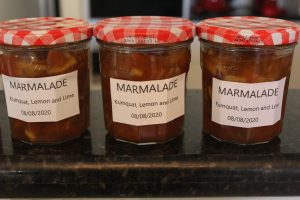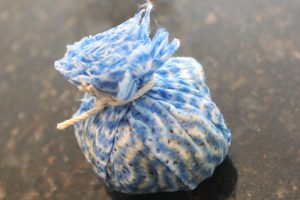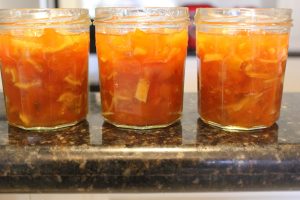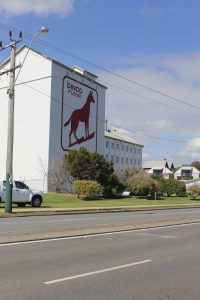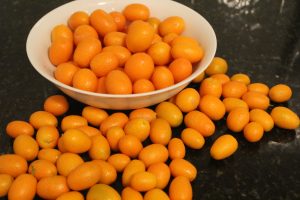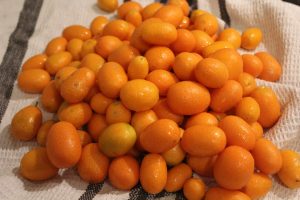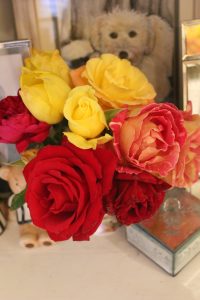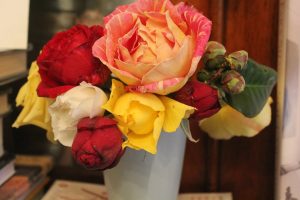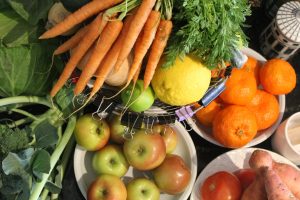Western Australia’s major agricultural crop is wheat, with about fifteen million tonnes produced annually. The grain production area, known as the Wheatbelt, covers seven million hectares ( about 17 million acres ). The area further south, the Great Southern region, produces grains, avocados, wine, strawberries, plus other berries and fruit.
Many towns in these regions have huge grain receival silos, often close to the town centre and always next to the train line. The grain is transported by rail from the silos to the ports of Fremantle, Bunbury, Albany and Esperance. Most of the grain is then shipped overseas in containers.
In March 2015 FORM, a West Australian not-for-profit art group, initiated The Silo Art program. The goal was to paint silos in the Wheatbelt and Great Southern regions. All the silos are at fully operational CBH Group grain receival sites. The first silo to be painted was in Northam in 2015 and is the first silo to be painted in Australia in mural form. The last, in Pingrup, was painted in September 2018. Much of the Wheatbelt is quite flat and the painted silos are visable from miles away.
We planned a four day trip to visit the silos and spend some time in the surrounding towns. When I first graduated as a teacher I was appointed to a very small town in the Wheatbelt but hadn’t visited the areas very often since then. Most of the roads were very good and the scenery was often spectacular.
DAY 1 NORTHAM Painted March 2015 Eight silos painted, four on each end. Artists Phlegm, from the UK and HENSE, an artist from USA. It took 16 days to complete and silos here sit in bucolic farmland.






DAY 1 MERREDIN Four silos painted by Kyle Hughes-Odgers who grew up in the area. Each silo is 35m ( 115 ft ) high and the entire project took 14 days to complete. Painted August 2017 using colours typical of the local landscape.


Left Merredin heading for Hyden, most famous for Wave Rock, where we stayed overnight.


An amusing stretch of fence decorated by shoes, boots, slippers, sandals and thongs. Went on for a long way!
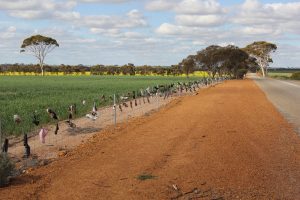

Too early to see many wildflowers but these were along the road heading to Hyden. Gorgeous colours.








Some local metalwork, Hyden.
DAY 2 NEWDEGATE via LAKE GRACE


DAY 2 NEWDEGATE Painted May 2018. The artist was Breton See and shows a mallee fowl, lizard, phascogale and tree frog. Silo height 20 metres (65ft).


DAY 2 PINGRUP


Painted September 2018 by Dominican born Evocal. It took 15 days. The silos are 25 metres (82ft) high and 15 metres (50ft) wide.


Day 2, heading for Albany. Canola crop with the Stirling Ranges behind.
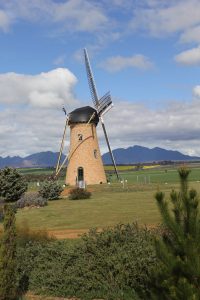

Fully operational five storey Dutch windmill used to produce spelt flour. There were also two typically Dutch cottages offering accommodation.
Day 3, ALBANY. Painted March 2018 by Yok and Sheryo (USA) It took 17 days and shows a Ruby Seahorse dragon, only found in the local coastal area.






There are many service providers in Western Australia, but we soon discovered that we were out of range or only had flaky communications once we left Merredin until we arrived in Albany. Only one provider covers the areas in between and there’s still gaps in service. So phone and tablet unusable, but wrote every night in my journal. And the pebble? I’ve collected and labelled a pebble in most of the places I’ve visited in the last thirty odd years.
DAYS 3 and 4 ALBANY


Replica landlocked brig of the Amity, a ship which sailed from Sydney to Albany, then known as Frederick Town, to resupply the military settlement 1826.
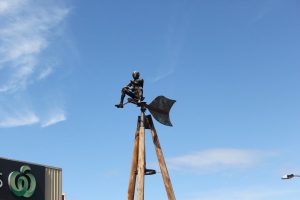

This weather vane on a round about in Albany made us smile. Left Albany heading for Kojanup. We had beautiful sunny, winter days and very cold nights.
DAY 4 KATANNING
There’s no silos in Katanning but plenty of street art and painted transmission boxes on school sites. In 2017 FORM arranged for school transformer boxes and some street walls to be painted. These murals were painted by Brenton See, Chris Nixon, Darren Hutchens, Mel Mcvee and the calligraphy was done by Karim Jabbari.








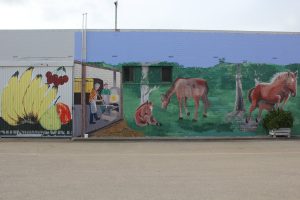

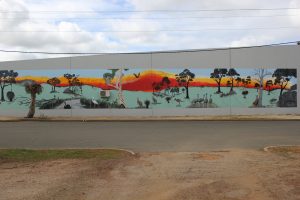



The old Premier Flour Mill has been converted into a luxury hotel. We enjoyed a lovely lunch there.
From Katanning we went back to Kojanup, then headed back to Perth. During our road trip we’d traveled about 1600 kms (1000 miles), seen amazing silo and street art, interesting towns, eaten some good food, met some lovely people and bought a few mementos. The artwork we saw on the silos, buildings and transmission boxes was remarkable and worth the journey.
There’s many online sites to help you plan your journey, book accommodation and learn more about the towns throughout the regions and their artworks.
WORLD PETROLEUM DAY
Yesterday was World Petroleum Day. Petroleum isn’t just for cars. It is used in plastics, detergent, rubber, fertilizers, pesticides, photographic film, makeup, candles and some medicines.

